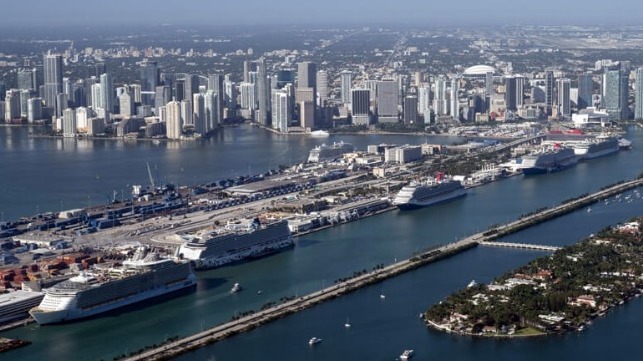NGO Predicts "Cruisezillas" Calling for Ticket Tax to Fund Green Fuels

The activist NGO Transport & Environment (T&E) is calling for a tax on the cruise industry to help fund the transition to zero carbon fuels and ensure the industry contributes its share to the ongoing efforts. The group cites the rapid growth of the cruise industry while forecasting the introduction of “cruisezilla” 345,000 gross ton cruise ship carrying nearly 11,000 passengers by 2050.
The NGO released a report highlighting that with cruise vacations increasingly becoming a mainstream vacation option, particularly in developed countries, the number and size of cruise ships have risen dramatically. The result, the report asserts is an exponential increase in cruise ships’ carbon emissions.
The report dubbed “Cruisezillas”: How much bigger can cruise ships get?, highlights that cruise ships are currently exempt from fuel duties, corporate taxes, and most of the consumer taxes that other modes of transport pay. As such, the NGO calls for imposing a €50 ($55) tax on a typical cruise ticket calculating that it would generate €1.6 billion ($1.7 billion) globally. They point out that €410 million ($450 million) would be raised in Europe which could be applied to the efforts to expand the supply of green fuels. The amounts could grow to $3.3 billion with a €100 per ticket fee or $6.8 billion with €200 per ticket fee.
T&E asserts that the rapid growth in the cruise industry has contributed to a dramatic increase in CO2 emissions. “A combination of more and bigger cruise ships,” T&E contends, “means that CO2 emissions from cruise ships in Europe were nearly 20 percent higher in 2022 than they were in 2019.
The report calculates that in Europe, CO2 emissions from cruise ships grew by 17 percent despite the COVID-19 pandemic, and methane emissions surged by 500 percent between 2019 and 2022. Other pollutants such as sulfur oxides, nitrogen oxides, and fine particles increased by nine percent, 18 percent, and 25 percent respectively around European ports during the period.
Cruise Lines International Association (CLIA), the trade group for the cruise industry, strongly contests those figures. In a statement, they cited EU data that they said shows “cruise lines have reduced emissions by 16 percent on average per ship over the past five years.”
“Today’s cruisezillas make the Titanic look like a small fishing boat,” said Inesa Ulichina, sustainable shipping officer at T&E. “How much bigger can these giants get? The cruise business is the fastest growing tourism sector and its emissions are quickly getting out of control.”
T&E highlights the transformation of the industry using data from Clarkson contending that the number of ships rose from 21 in 1970 to 515 today. They also assert that the average size of the ten largest cruise ships is double what it was 24 years ago, averaging 205,000 gross tons. The group says nearly 36 million travelers are projected to take a cruise voyage this year.
Illustrating the growth, T&E points to Royal Caribbean International’s Icon of the Seas, which was introduced at the start of the year as the world’s biggest cruise ship. With a capacity of 7,600 passengers, the Icon of the Seas they said not only dwarfs the 1999-built Voyager of the Sea (then the largest cruise ship in the world) that has a capacity of 3,938 passengers, and they compared it to the Titanic (46,000 gross tons) which had a capacity of 2,500 passengers. Going by the current trend, T&E projects the trend will continue to “cruisezillas” in the range of 345,000 gross tons and nearly 11,000 passengers by 2050.
The trade group CLIA says it has concerns over “multiple claims” in the report. For example, they report that the majority (60 percent) of cruise ships sailing today and scheduled for service in the next decade are small-to-midsize and more energy efficient. CLIA also points to the investments being made by the industry to increase the use of sustainable fuels and new technologies.
T&E acknowledges that many cruise operators are switching to LNG as an alternative to traditional shipping fuels like heavy fuel oil. They recognize that LNG-powered ships make up 38 percent of today’s global cruise ship orders, but raise the concerns of methane slip.
Cruise ships, T&E highlights, are good candidates for green fuels despite the limited availability and challenges in bunkering for the new fuels. The NGO highlights the concerns over supply and bunkering would be less for cruise ships that sail on the same routes with clear schedules versus commercial shipping.
The report concludes by saying converting cruise ships to green fuels would also be financially beneficial for the lines. T&E points to the increasing scale of financial penalties associated with fossil fuel under the Fuel EU Maritime scheme and the financial benefits for cruise ships to lead in the green fuel transition.
